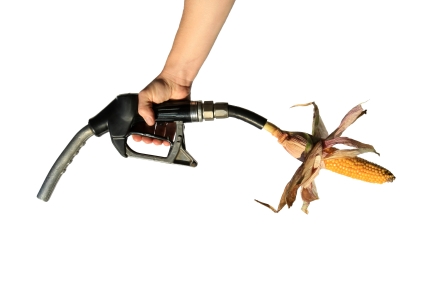
Agricultural News
Report: Corn Ethanol Waiver's Effect on Corn Prices Depends on Oil Prices
Thu, 16 Aug 2012 10:33:25 CDT

Corn prices pushed higher by the worst U.S. drought in half a century would not necessarily moderate if the federal government's corn ethanol mandate were temporarily suspended and if oil prices rose dramatically at the same time, according to a report by three Purdue University agricultural economists.
The report, Potential Impacts of a Partial Waiver of the Ethanol Blending Rules, suggests that under some scenarios with certain market conditions, corn prices could fall if the U.S. Environmental Protection Agency (EPA) granted a partial waiver of the Renewable Fuel Standard's corn ethanol provision. EPA received a request by a consortium of livestock industry organizations to waive part of the mandate that effectively requires that corn ethanol be blended with gasoline.
In collaboration with Purdue, the Farm Foundation, NFP hosted a web conference Aug. 16, during which the report's authors will discuss their findings. The conference will be archived on the Foundation's website where the full report is posted. Click here to go there.
According to the three Purdue economists who authored the paper--Wally Tyner, Farzad Taheripour and Christopher Hurt--a waiver could, under certain conditions, reduce the demand for corn and, thus, corn prices for livestock producers and other non-ethanol corn buyers.
Under its normal schedule, EPA has until October to gather information on the extent of any economic harm done by the original Renewable Fuel Standard level and to decide if it will issue a waiver. For consumers, the decision could affect what they pay for fuel and food.
"The range of impact of a RFS waiver goes from zero to $1.30 per bushel for corn," says Tyner, an energy policy specialist and the report's lead author.
With corn crops shriveling in the field and yield projections dropping almost weekly, corn prices have jumped 60% since June 15. A bushel of corn has topped $8. The prospect of a diminished crop and even higher corn prices has livestock producers worried that corn--a feed mainstay--might not be available or will be too expensive to buy.
The RFS mandates 13.2 billion gallons of ethanol be blended with gasoline in 2012; that number increases to 13.8 billion gallons in 2013. Because oil companies blended 2.6 billion gallons of ethanol with gasoline above what was required in previous years, they have built up blending credits--known as renewable fuel identification numbers (RINs). Blenders are allowed to count RINs toward blending totals in this or future years.
In their study, Tyner, Hurt and Taheripour looked at future corn and ethanol prices with and without an RFS waiver, how RINs and crude oil prices could factor in ethanol use, and what might occur if the drought worsens.
"If corn prices remain high, which seems likely, and crude oil remains at $100 a barrel or lower, then reducing the RFS could reduce the demand for ethanol and, consequently, the demand for corn," Tyner said. "If the waiver resulted in less demand for ethanol that would, in turn, lead to lower corn prices than would have existed without the waiver. It also could lead to more ethanol plant closings--at least temporarily."
Conversely, an EPA waiver could have little effect if crude oil moves beyond $120 a barrel and oil companies continue blending ethanol at current levels, Tyner said.
The severity of drought conditions moving forward adds another layer of complexity to the issue, the economists said. At the start of the current crop season, U.S. corn production was projected at 14.7 billion bushels, with a U.S. farm price of $5.34 per bushel. USDA now estimates U.S. corn production will reach only 10.8 billion bushels this year, with the price $8.20 a bushel. If the drought strengthens and EPA sticks to the mandated 13.8 billion gallons of ethanol in 2013, a corn crop of 10.5 billion bushels could push corn prices to $8.57 per bushel, according to the Purdue report. If drought conditions abate and corn production reaches 11.5 billion bushels, corn prices could fall to $7.02 a bushel under a full RFS ethanol mandate.
"However, because of carry-forward blending credits from prior years--the RINs--refiners and blenders could decide to produce and blend 2 billion fewer gallons of ethanol," Tyner said. "That change alone could reduce the price of corn around 67 cents a bushel. And that is without any EPA waiver."
EPA will have much to consider before rendering its waiver decision, Tyner said. "It will have to determine what impact issuance of a waiver actually would have, given the way the market functions at present," he said. "For technical and economic reasons, refiners may well continue to use nearly the same amount of ethanol, even if they are not required to because of a waiver. Technically, they may not want to change their current mix of gasoline and ethanol to make 87-octane gasoline, as an example. Economically, they would not be expected to reduce ethanol use as long as ethanol prices are below gasoline, as they are now. If refiners and blenders don't have or choose not to use operating flexibility, and if reduced use of ethanol is not economical, then a waiver would have no impact."
Tyner continued: "To the extent that refiners and blenders do have flexibility with their use of ethanol, a small waiver could reduce corn prices around 47 cents a bushel, while a large waiver could reduce it as much as $1.30 a bushel, depending on economic conditions."
Should a waiver lead to reduced ethanol use, EPA could have an influence on who bears the brunt of the drought-related corn losses, Tyner said. "The total amount of harm from the drought is in the tens of billions of dollars," he said. "The EPA cannot change the loss. It can only potentially redistribute it among the affected parties: ethanol producers, livestock producers, corn growers and domestic and foreign consumers."
WebReadyTM Powered by WireReady® NSI
Top Agricultural News
More Headlines...



















